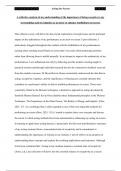Acting for Screen
A reflective analysis of my understanding of the importance of being receptive to my
surroundings and my impulses as an actor to enhance truthfulness on screen.
This reflective essay will delve into the crucial exploration of receptiveness and its profound
impact on the authenticity of my performance as an actor on screen. Upon reflection, I
particularly struggled throughout this module with the truthfulness of my performances,
sensing when watching myself back on screen that I was more often portraying emotions
rather than allowing them to unfold naturally. In an attempt to improve the authenticity of my
performances, I was influenced not only by following specific models of acting taught in
practical sessions and through individual research but also by constructive feedback received
from the module convenor, Dr Bryan Brown. Bryan consistently underscored the idea that in
acting, receptivity, impulses, and the significance of listening are essential elements that
contribute to a performer's ability to deliver truthful performances on screen. These were
commonly related to the Meisner techniques, a distinctive approach to acting developed by
Stanford Meisner himself. Kevin Otos identifies three fundamental principles in the Meisner
Technique; ‘The Importance of the Other Person, The Reality of Doing, and Impulse’ (Otos,
2021: 27). As a technique that is often regarded as one of the most impactful methods for
performing on screen (Otos, 2021: 155), I intend to explore these core concepts and discuss
the extent to which acting methods have been instrumental in enhancing my acting on-screen.
In learning to apply these acting theories, I particularly feel the most transformative outcomes
of my acting stemmed from a concentrated state of receptivity and a commitment to
understanding the importance of relying on my instincts. I aim to reflect on my progress in
understanding these concepts and explore the resulting implications and outcomes. Although
it has been exclaimed that ‘Acting in any medium requires a constant state of receptivity’
(Anon, n.d.), my reflection will delve into the essential reliance on receptivity as a screen
, Acting for Screen
actor. In contrast to a stage actor, the fragmented nature of a screen actor's performance
demands complete receptiveness in the immediate moment of a scene, as opposed to drawing
on the emotional momentum built from previous moments on stage. In explaining the
importance of focusing on your responses as an actor, Patrick Tucker recognises the necessity
for actors to adapt their technique from the stage, acknowledging that a character's reactions
hold greater importance (Tucker, 2023: 12). In explaining his insights on the essence of
compelling screen performance in his book "Secrets of Screen Acting," Tucker underscores
the significance of reacting when performing in front of a camera. He articulates that ‘screen
acting is as much about reacting as it is about acting’ (Tucker, 2023: 81) and emphasises the
notion that ‘movie acting is reacting’ (Tucker, 2023: 81). Moreover, I will reflect on the
focus required to immerse myself in a state of receptiveness and the transformative
adjustments to my acting process. In alignment with this perspective, Churcher also
subscribes to the belief that ‘Acting is interacting, reacting, and being in that moment’
(Churcher, 2014:152) which resonates strongly with not only Tucker's argument but also the
essence of the Meisner technique. Furthermore, these statements encapsulate the focal points
of my analysis in this essay, emphasising the significance of being fully present mentally and
physically, relying on my impulses, and maintaining an active engagement with fellow
actors.
As I reflect on the practical exercises we undertook this term, the significance of
receptivity was consistently emphasised and, therefore, heavily influenced how I performed
in both my monologues and duologues. This theme resurfaced notably during a repetition
exercise where Rachel and I had to repeat “You have brown eyes” back and forth to each
other. This repetition exercise is one of the key training associated with the Meisner
Technique and is seen as, according to Otos, ‘one of Meisner’s great contributions to actor




